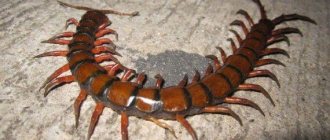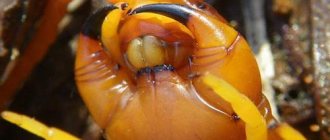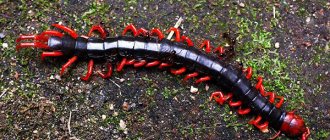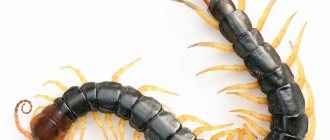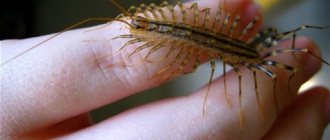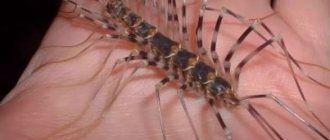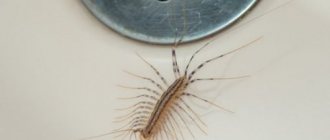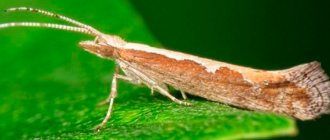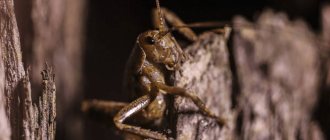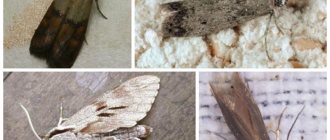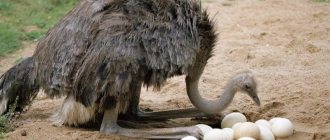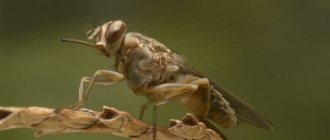There are many unpleasant and exotic creatures living on planet Earth. One of them is a giant scolopendra. This arthropod is simply enormous in size. But at the same time he behaves quickly, secretly and aggressively. Is scolopendra dangerous for humans? What harm can it do? We will answer all these questions and tell you in detail about this unusual centipede.
Appearance and dimensions
Most people agree that the giant scolopendra looks completely unattractive. Although, more often than not, it is not the appearance of this arthropod that is frightening, but its size. The color of the giant scolopendra is reddish-brown. Occasionally there are red, green, blue and even purple specimens. The body length of this creeping creature reaches 25-30 cm. Moreover, it consists of 23-25 sections, each of which has a pair of fast and relatively long legs (about 2-2.5 cm) with dark claws.
Its head looks like a flattened plate with eyes, two antennae and poisonous jaws, into which the front legs were transformed during evolution. The claws of the giant scolopendra are very tenacious, thanks to which it easily moves on any surface. The centipede has large legs growing from behind. They serve as a kind of “anchor” and help to move through burrows, crevices, earthen passages and other bottlenecks.
You can study the appearance of this creature in more detail by viewing the photos below.
For reference! According to known facts, the largest scolopendra was discovered in Brazil. Her body length was 33 cm.
Description
As you can see in the photo, the domestic scolopendra has an elongated body of yellowish-gray or brown color, decorated with three dark stripes. Moreover, its dimensions can range from 3.5 to 6 cm.
The external, or external, skeleton consists of sclerotin and chitinous cover. The body has a flattened shape and is divided into 15 segments, each of which bears a pair of legs. The longest walking limbs are the latter.
Because of their appearance, it is the last legs that often make it difficult to determine where the flycatcher’s head is. The front pair of legs are well developed - with them the scolopendra captures prey and attacks the enemy.
The head has compound eyes and long 600-segment whip-like antennae.
The body structure of young flycatchers is somewhat different. They have only four pairs of walking limbs. Their number increases with each molt - the domestic scolopendra acquires several legs after each moult: first there are 10, then 14, 18 and 26. After the last change of chitinous cover, the number of legs reaches 30.
Lifestyle and behavior
House scolopendra is able to remain active at any time of the day. It moves at an enviable speed - about 40 cm/sec. When moving, the flycatcher lifts its long body above the ground and deftly rearranges its numerous legs.
A pair of compound eyes are quite well developed, which allows this scolopendra to detect prey without much effort. For this reason she is an excellent hunter
Sitting on the wall, the flycatcher waits for prey, ready at any moment to pounce on any careless insect
As for the taste preferences of this centipede, it can eat:
- flies and their larvae;
- crickets;
- worms;
- silver coins;
- snails;
- fleas;
- cockroaches;
- moth;
- ants.
The domestic scolopendra is “informed” that a potential victim is nearby not only by its eyes, but also by its long, hypersensitive antennae, which are capable of recognizing both touches and smells. As soon as the prey is in the paws, the flycatcher immediately plunges its fangs into its body and injects poison. And after the meal, she tries to hide in a dark place and wait until the food is digested.
Habitat
The Latin name of this arthropod is scolopendra gigantea . Belongs to the animal kingdom. But it is not an insect. This is an arthropod from the class of labiopods. It lives mainly in the tropics and subtropics. To be more precise:
- In South America;
- in Jamaica;
- to Puerto Rico;
- in Trinidad and other Caribbean islands.
In Europe, Asia and Africa, the giant scolopendra, fortunately, is not found. Is this arthropod found in the Seychelles, where more than 200 thousand tourists from all over the world vacation annually? No, but other species of scolopendra live there, which, by the way, can bite a person. So when going to this “paradise on earth”, you should be careful and avoid contact with such unpleasant centipedes.
Where does the praying mantis live?
Photo: Bogomol in Russia
The habitat of mantises is very extensive and covers many countries in Asia, Southern and Central Europe, Africa, and South America. There are numerous populations of mantises in Spain, Portugal, China, India, Greece, and Cyprus. Some species live in Belarus, Tatarstan, Germany, Azerbaijan, and Russia. Predatory insects were introduced to Australia and North America, where they also reproduce successfully.
In tropical and subtropical conditions, mantises live:
- in forests with high humidity;
- in rocky deserts warmed by the scorching sun.
In Europe, mantises are common in steppes and spacious meadows. These are heat-loving creatures that do not tolerate temperatures below 20 degrees very well. Recently, some areas of Russia have periodically been subjected to real invasions of praying mantises, which migrate from other countries in search of food.
Mantises change their habitat very rarely. Having chosen one tree or even a branch, they remain on it all their lives if there is enough food around. Insects actively move only during the mating season, in the presence of danger or in the absence of the required number of objects for hunting. Praying mantises thrive in terrariums. The most comfortable ambient temperature for them is 25-30 degrees with a humidity of at least 60 percent. They do not drink water, since they get everything they need from food. Under natural conditions, some more aggressive and powerful species can displace smaller ones, even to the point of complete extermination in a certain area.
Now you know where the praying mantis lives. Let's find out what the insect eats.
Lifestyle and reproduction
The arthropod prefers to behave secretly. During the day it hides in rock cracks, under stones, trees and other similar places where it is not so hot. So, the scolopendra is hiding from its enemies - various mammals and birds who are not averse to hunting it. At night, the centipede comes out of hiding in search of various invertebrates, which are its main food.
Surprisingly, the huge scolopendra has poor eyesight. More precisely, it distinguishes only between light and darkness. Because of this, she behaves aggressively - in any incomprehensible situation (for example, meeting a person or animal), she prefers to attack, suspecting danger.
The giant scolopendra is capable of developing decent speed when hunting, and the agility and mobility of its body allows it to attack even small and nimble birds.
Scolopendras are individualists and live alone. They rarely conflict with each other. Having met, two individuals usually disperse peacefully. Scolopendra reaches sexual maturity at 2-3 years of age. In this case, the female can mate several times within one year.
By the way, this unpleasant animal is considered a caring mother. Scolopendra protects the eggs and hatched offspring by wrapping their legs around them. It can thus cover the entire clutch, which can contain up to 100 centipedes. The female fiercely attacks everyone who approaches the shelter and her children. At the same time, the giant scolopendra not only protects the eggs, but also cleans them, applying special substances to them so that they do not become covered with mold or dirt, and also do not dry out.
Small white centipedes are born. They have soft bodies a couple of centimeters long. They don’t live with their mother for long – after a few days they go out on their own to look for food. The plates on the shell of centipedes gradually darken. But their color changes until they reach maturity.
For reference! The ancestor of scolopendra gigantea is believed to be the prehistoric scolopendra arthropleura. The length of her body could reach 2.5 meters. There was such an ancient and huge centipede approximately 300-340 million years ago.
Prevention measures
If you take some preventative measures, insects such as centipedes will never appear in your house. All you need is:
- Get rid of everything that could be a comfortable breeding ground for these insects.
- If there is a toilet in the yard, it is better to regularly fill it with sawdust and ash.
- Bring the house into a normal sanitary condition so that insects that centipedes feed on cannot appear in it.
- Dry all rooms, getting rid of unwanted high humidity, which attracts not only centipedes.
- Make sure that there are no holes or cracks in the house through which insects can enter the house.
- Use boric acid powder to control insects by scattering it in problem areas.
- It is advisable to close the bathroom and sinks with special plugs at night.
- If the floors are wooden, then it is better to treat them with parquet mastic.
Despite its frightening appearance, with which the scolopendra scares household members, you should not be afraid of it, but on the contrary, you need to make sure that this insect remains alive. At the same time, you should think carefully about why she became interested in housing. It is quite possible that it is time to start fighting with other uninvited guests by starting a general cleaning of all premises.
Scolopendra bite!
Watch this video on YouTube
What does it eat?
The diet of huge centipedes mainly contains invertebrate animals - larvae, earthworms, beetles, etc. At the same time, scolopendra can hunt anyone who does not exceed it in size. For example:
- snake;
- birds;
- rodents;
- frogs;
- lizards, etc.
Roughly speaking, giant centipedes can eat anyone they can handle. Even bats sometimes become their food. How does the centipede manage to catch them? It’s quite simple - it climbs up the cave arches, finds a sleeping bat and then digs into the victim with its front poisonous claws, killing it.
Due to the peculiarities of digestion (its primitive structure) and its small mouth, it eats slowly. Pauses periodically. If the prey is large, the process of absorbing it may take several hours.
For reference! The giant scolopendra lives quite a long time. Most individuals die at the age of 5-7 years. At least in captivity. Under natural conditions, the average lifespan of this invertebrate is about 2 years.
Features of the life of a poisonous centipede
Scolopendra are bright representatives of the genus of labiopods. Their distinctive feature is modified forelimbs that have turned into jaws. The body consists of segments, the number of which varies from 21 to 25 in different species. Each segment has its own pair of legs ending in sharp claws. The segmented antennae serve as organs of touch.
The variety of colors attracts attention to these creatures. Their paint contains red, blue, orange, purple, yellow and numerous combinations
Giant scolopendra
A variety of species and colors of scolopendra are found in hot tropical forests. The largest representatives of the family, the giant centipedes, live here. The average length of their body is 30 cm, but there are individuals up to 45-50 cm. They choose prey equal in size to themselves. But an aggressive manner of attacking any danger can provoke a person to bite. Scolopendra is a long-lived invertebrate; in captivity there are individuals that have lived up to 7 years.
Nutrition and reproduction
Scolopendras are nocturnal predators; they hide from the sun's rays, which dry out their bodies. Creatures live in crevices, under stones, in holes. Agile animals move quickly on numerous legs not only on horizontal, but also on vertical surfaces, and climb onto the ceiling of a cave or house. Centipedes hunt insects, small rodents, snakes and lizards.
During the breeding season, males lay a special sac with seed - a spermatophore. Females are fertilized by crawling over it. Caring mothers protect the eggs from danger for several weeks, covering them with their own paws. After the offspring appear, the female crawls away. The white, soft-bodied babies grow on their own, becoming more adult-like with each molt.
Poisonous apparatus
In order to have a good idea of the consequences of a scolopendra bite, it is worth considering the structure of its poisonous apparatus. The jaws with which the centipede catches prey consist of 6 segments. The outermost one is a sharp claw, curved inward. The venom gland channel runs inside the maxillary. At the tip of the claw there is a hole through which the toxin is injected into the victim. It contains substances that cause severe pain, tissue numbness, swelling and inflammation. Painful sensations last from several hours to several days.
Danger to humans
An encounter with a giant scolopendra can lead to unpleasant consequences. Especially, you need to try to avoid its bite, in which the centipede secretes a strong poison that can cause in humans:
- numbness;
- temporary paralysis of the limbs;
- pain (in terms of pain, the bite of a giant scolopendra is comparable to the sting of two dozen bees);
- tumor;
- chills;
- heat;
- weakness, etc.
The venom of the giant scolopendra is lethal only for small animals. For humans, this is a powerful toxin that can worsen their well-being and cause a number of unpleasant reactions that can persist for several days. However, if such a centipede bites a small child or an allergy sufferer, then there is a high risk of angioedema, and with it death.
Naturally, you shouldn’t even pick up a giant scolopendra. Her claws on each pair of legs contain poison. Once on the skin, it can cause some kind of burn marks, redness, irritation and blisters.
Feeding a praying mantis
The praying mantis is a predatory insect, so it feeds on insects, such as mosquitoes, flies, bugs, cockroaches and bees. Occasionally, even small lizards, frogs, birds and some small rodents become its prey.
The appetite of these insects is very good, and literally in a matter of months one individual is capable of eating several thousand insects of various sizes from grasshoppers to aphids. In some cases, the praying mantis can even attack animals with a backbone.
Mantises are also characterized by cannibalism, that is, eating their relatives. For example, it often happens that a female praying mantis eats a male immediately after the mating process, but sometimes she can eat him without waiting for the end of lovemaking.
To prevent this from happening, the male praying mantis is forced to perform a kind of “dance”, thanks to which the female is able to distinguish him from the prey and thereby keep him alive.
The photo shows the mating dance of a praying mantis
The praying mantis can sit motionless for a long time, merging with the surrounding vegetation, waiting for its prey.
When an unsuspecting insect or animal approaches the mantis, it makes a sharp lunge and grabs the victim with the help of its forelimbs, which have dangerous spines.
With these same paws, the mantis brings the prey directly to its mouth and begins to absorb it. It should be noted that the jaws of these insects are surprisingly well developed, so that it can easily “grind” a not very large rodent or a medium-sized frog.
If the potential prey is quite large, the mantis prefers to approach it from the back, and when it approaches it at a close distance, it makes a sharp lunge to capture it.
In general, the main diet of this insect is considered to be small insects; it can start hunting for lizards and mice, being extremely hungry. In this case, he can easily turn from a hunter into a victim.
How to protect yourself?
It should be remembered that the giant scolopendra is not an insect, and therefore fumigators and various aerosols do not affect it. You can kill it mechanically, but it’s difficult to do. This centipede is very nimble.
It is best to follow basic safety precautions. In areas where giant scolopendras live, wear thick clothing that covers most of your body. Don't sleep outside your tent. Carefully turn over old logs and stones - centipedes often choose these places for shelter.
When meeting her, try to simply avoid direct contact, bite, or touching your skin with the legs of the centipede. If you are unable to protect yourself, do the following:
- Wash the bite or contact area with cool water and soap.
- Disinfect the skin with alcohol or any other antiseptic.
- Apply a sterile dressing. Change it after 12 hours.
- Take an antihistamine.
- Drink more fluids, but avoid alcohol (it speeds up metabolism and thereby enhances the effect of the poison).
- Stay calm and monitor your condition.
- Contact your doctor if you feel unwell.
What to do when an insect bites you
The sensation of a scolopendra bite is similar to that of several bees stinging at once. The poison acts instantly. This is why the skin turns red. Children's delicate skin is especially sensitive to bites. But adults also feel acute pain and malaise.
If possible, avoid contact with the scolopendra, its legs, and do not allow it to bite. It is not always possible to protect yourself from an unpleasant meeting. If contact or a bite occurs, proceed as follows:
- Wash the bite area with soap and plenty of water.
- Disinfect the wound with alcohol or vodka.
- Take a sterile bandage and wrap the affected area for 12 hours. Remove and throw away the old bandage, apply a new one.
- Now the patient needs to lie down quietly. Try not to be nervous.
- You should not drink alcohol during the period of poisoning. Alcohol speeds up the body's metabolism, and the toxic substance will spread through it faster.
- You should definitely go to the hospital: women, pregnant women, children, the elderly. And also for those who have heart problems.
Take care of yourself, because after the bite of a sick, weakened person or an allergy sufferer, there have been deaths.
Giant scolopendra as a pet?
Lovers of exotic animals and various invertebrates sometimes keep such huge centipedes at home. They are fed with worms, beetles, large cockroaches, small frogs and lizards. Such animals do not need a large amount of food. For example, 5-6 cockroaches are enough to feed you for a whole month. After all, you should feed the centipede only 1-2 times a week.
Scolopendras must be kept in high and large terrariums (at least 40x40x40 cm). Must be closed at the top. Otherwise, the pet may jump out of there.
If you also decide to have a centipede at home, then do not forget that the following conditions are necessary for its existence:
- The soil must be constantly moist. But not too wet. It is best to pour a thick layer of substrate, at least 10 - 12 cm.
- The optimal humidity in the terrarium is around 70-80%.
- Air temperature is from 25 to 29 degrees Celsius. At night it is desirable that it be cooler - from 17 to 22.
- Constant access to a drinking bowl with settled water.
You most likely won’t be able to buy a giant scolopendra in a regular pet store. You can search for advertisements for the sale of animals on the Internet. The price for a centipede will most likely be no less than a couple of thousand rubles.
